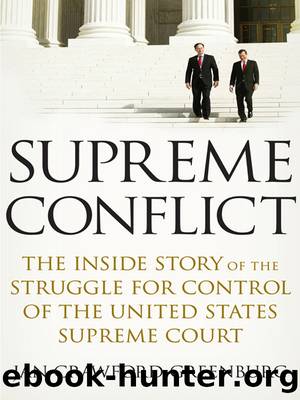Supreme Conflict by Jan Crawford Greenburg

Author:Jan Crawford Greenburg
Language: eng
Format: epub
Publisher: Penguin Publishing Group
Published: 2007-10-15T00:00:00+00:00
8.
THE NATURAL
About a month after a dying Rehnquist swore in President Bush to a second term, David Leitch, one of Bushâs senior advisers, packed up his office in the West Wing. Leitch had worked two years as the deputy White House counsel, and he was heading off to the more lucrative private sector to be the general counsel at Ford Motor Company. But before he left the White House for good, Leitch needed one more meeting with Karl Rove. He wanted to share his insight on possible candidates to replace Rehnquist when he retired, as most expected, in June.
Leitch was uniquely positioned to give Rove authoritative advice. He had worked with all of the top contenders and knew them personally. Heâd clerked for federal appeals court judge J. Harvie Wilkinson after law school. Heâd gone on to work in the Justice Department for J. Michael Luttig, and he later became law partners with John G. Roberts in the Washington-based firm of Hogan & Hartson. For the past two years, Leitch had worked directly with White House Counsel Alberto Gonzales. He also understood what the job of chief justice entailed. Leitch had clerked for Rehnquist on the Supreme Court just a few years after Roberts did.
Leitch sent Rove an e-mail in late February, asking for a meeting to talk about the Supreme Court. Several days later, on Leitchâs last day in the White House, the two sat down together for breakfast. Rove listened intently as Leitch went through the possible nominees. Leitch said they all had their strengths, even Gonzales, whom conservatives vociferously opposed. âTheyâre all great,â Leitch emphasized to Rove.
But one stood out. Roberts.
âIf the president picks Roberts, you can sell him as the nominee who was selected purely on the meritsâthe quality candidate,â Leitch told Rove. âHeâs the best Supreme Court advocate of his generation. Democrats canât attack him. Enough Republicans know him, and know heâs not David Souter. Heâs going to be reliable. People will love him. The president will love him.â
Rove did not disagree. John Roberts was widely considered one of the top lawyers to argue before the Supreme Court, an assessment shared by Democrats and Republicans alike, as well as by liberal justices like Ruth Bader Ginsburg. An honors graduate of Harvard Law School, heâd come to Washington in 1980 to clerk for thenâassociate justice William Rehnquist. He stayed to work as a lawyer in the Ronald Reagan and George H. W. Bush administrations. As deputy solicitor general for the elder Bush, Roberts represented the administrationâs position in the Supreme Court. He was poised to become a judge in 1992, when Bush nominated him to the D.C.-based federal appeals court. But Robertsâs nomination, coming at the end of Bushâs term, languished in the Democrat-controlled Judiciary Committee and died when Bill Clinton was elected. With a Democrat in the White House, Roberts left government service and moved to Hogan & Hartson, where he quickly became one of the nationâs top appellate lawyers and was regularly called upon to argue before the Supreme Court.
Download
This site does not store any files on its server. We only index and link to content provided by other sites. Please contact the content providers to delete copyright contents if any and email us, we'll remove relevant links or contents immediately.
The Secret History by Donna Tartt(18168)
The Social Justice Warrior Handbook by Lisa De Pasquale(11956)
Thirteen Reasons Why by Jay Asher(8457)
This Is How You Lose Her by Junot Diaz(6441)
Weapons of Math Destruction by Cathy O'Neil(5835)
Zero to One by Peter Thiel(5495)
Beartown by Fredrik Backman(5366)
The Myth of the Strong Leader by Archie Brown(5240)
The Fire Next Time by James Baldwin(5021)
How Democracies Die by Steven Levitsky & Daniel Ziblatt(4964)
Promise Me, Dad by Joe Biden(4909)
Stone's Rules by Roger Stone(4865)
100 Deadly Skills by Clint Emerson(4694)
A Higher Loyalty: Truth, Lies, and Leadership by James Comey(4554)
Rise and Kill First by Ronen Bergman(4547)
Secrecy World by Jake Bernstein(4390)
The David Icke Guide to the Global Conspiracy (and how to end it) by David Icke(4384)
The Farm by Tom Rob Smith(4328)
The Doomsday Machine by Daniel Ellsberg(4248)
